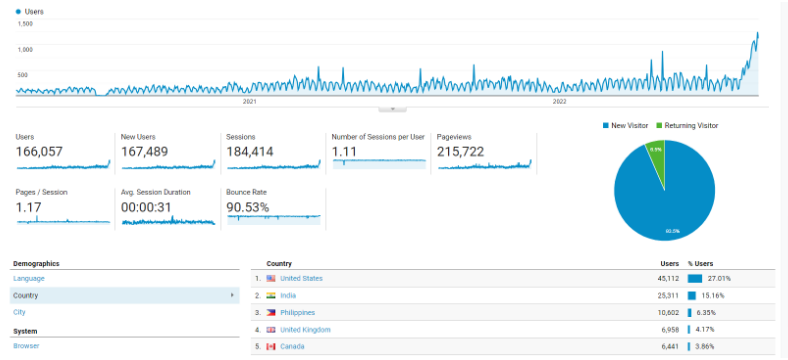In the continuously evolving field of Software as a Service (SaaS), content marketing has become an invaluable asset for companies looking to solidify their online presence, connect with their desired audience, and enhance customer acquisition efforts.
While the basics of content marketing are crucial, taking your SaaS content strategy to the next level requires a deeper understanding of your audience, a commitment to providing value, and a strategic approach that goes beyond the fundamentals.
Content Marketing for SaaS: Basics
Here are some basic steps to implement to get started with content marketing for your SaaS business.
#1. Define Your Goals and Target Audience
Defining your goals and target audience is a crucial initial step. Clearly outline your marketing objectives and identify the specific group of individuals you want to reach with your content.
By defining your goals, you set benchmarks for success, and by identifying your target audience, you ensure that your content speaks directly to the people who are most likely to benefit from and engage with your SaaS offerings. This strategic approach maximizes the effectiveness of your content marketing efforts and contributes to the overall success of your SaaS business.
Define Your Goals:
Establish the purpose and desired outcomes of your content marketing efforts. SaaS companies may have various goals for individual marketing campaigns, such as increasing brand awareness, driving customer acquisition, or improving user engagement. Defining these goals provides a clear direction for your content strategy and allows you to measure success effectively.
Identify Your Target Audience:
Understanding your target audience is fundamental to crafting content that resonates with them. In the SaaS industry, the audience may include tech-savvy professionals, decision makers, and end-users. It’s essential to create detailed buyer personas that outline the demographics, behaviors, challenges, and preferences of your ideal customers. This information guides content creation, ensuring that it is tailored to meet the specific needs and interests of your audience.
#2. Research Your Audience
Key aspects of audience research in SaaS content marketing include:
- Demographics. Understand the basic characteristics of your audience, such as age, gender, location, and job title. In the SaaS domain, this might involve identifying the industries your audience operates in and specific roles within those industries.
- Psychographics. Dive deeper into the psychological aspects of your audience, including their attitudes, values, interests, and pain points. For SaaS, this could involve understanding their challenges in adopting new technologies, their preferences for certain features, and their goals in using SaaS solutions.
- Behavioral patterns. Analyze how your audience interacts with content online. Identify the platforms they use, the type of content they consume, and their preferred communication channels. This information helps in tailoring your content distribution strategy to effectively reach your audience.
- Feedback and interactions. Actively seek and analyze feedback from your audience. This could come from customer support interactions, social media comments, surveys, or other feedback mechanisms. Understanding what your audience is saying about your product and content helps in refining your approach.
- Competitor analysis. Study the content strategies of competitors targeting a similar audience. Identify gaps or areas where you can differentiate your content and provide unique value.
- Trends and industry insights. Stay updated on industry trends, challenges, and emerging technologies relevant to your SaaS audience. This ensures that your content remains relevant and addresses current issues.
Content Marketing for SaaS: Beyond the Basics
While the importance of content marketing in the SaaS sector is well established, the landscape is not static. To thrive in this ever-changing environment, SaaS businesses must take their content marketing beyond the simple basics. They must adopt advanced strategies and tactics that not only engage their target audiences but also drive growth, foster brand loyalty, and establish thought leadership.
#1. Track Key Content Metrics Based on Your Goals
By tracking key content metrics based on your goals, you ensure that your content marketing strategy remains aligned with your business objectives. This data-driven approach allows for continuous improvement, helping you refine your content efforts for maximum impact in the competitive landscape of SaaS.
Select Key Metrics:
Once your goals are established, determine the key performance indicators (KPIs) or metrics that directly align with each goal. For example:
- Brand awareness. Track metrics like website traffic, social media reach, and brand mentions.
- Lead generation. Monitor conversion rates, form submissions, and the number of leads generated.
- Product adoption. Measure user engagement, feature usage, and onboarding completion rates.
- Customer retention. Assess customer satisfaction scores, churn rates, and customer loyalty metrics.
Utilize Analytics Tools:

Source: Internet eBusiness Solutions, Inc
Implement analytics tools, such as Google Analytics, social media analytics, or SaaS-specific analytics platforms, to gather data on user behavior, content performance, and audience demographics. These tools provide valuable insights into how your content is being consumed and its impact on your goals.
Regularly Evaluate Performance:
Regularly assess the performance of your content against the defined metrics. This allows you to identify trends, successes, and areas for improvement. Adjust your content strategy based on the insights gained from these evaluations.
A/B Testing:
Experiment with variations of your content to optimize performance. A/B testing involves creating two or more versions of a piece of content and comparing their effectiveness in achieving specific goals. This can be applied to email subject lines, website layouts, call-to-action buttons, and more. However, it’s not advisable to employ this strategy for entire blog posts. Doing so may lead search engines to interpret it as plagiarism, and you could end up undermining the integrity of your own content.
Iterative Optimization:
Use the data collected to continually optimize your content strategy. If certain types of content or distribution channels consistently outperform others, allocate more resources to those areas. Conversely, if certain strategies are not yielding the desired results, adjust your approach accordingly.
#2. Conduct In-Depth Keyword Research

Source: Red River
By conducting in-depth keyword research, you enhance the discoverability of your SaaS content, increase the likelihood of appearing in relevant search results, and attract users actively seeking information related to your industry. This strategic approach contributes to a more effective and targeted content marketing strategy for your SaaS business.
- Identify relevant keywords. Begin by identifying keywords and phrases that are directly related to your product, features, and the problems it solves. Think about the language your target audience might use when searching for solutions in your industry.
- Long-tail keywords. Consider incorporating long-tail keywords, which are more specific and detailed phrases. These often have lower search volumes but can be highly valuable, since they typically indicate more intent and a higher likelihood of conversion.
Let’s consider a SaaS company that provides employee training software as its primary offering. The primary keyword could be “employee training software”, while the long-tail keyword could be “cloud-based employee training software for small businesses.”
In this case, the long-tail keyword adds specificity by targeting a niche audience (small businesses) and emphasizing a particular feature (cloud-based). While the search volume for this long-tail keyword might be lower, it can attract highly targeted traffic, as users searching for this term likely have a clear understanding of their needs and are more likely to convert into customers. - Competitor analysis. Analyze the keywords your competitors are targeting. Tools like Google Keyword Planner, SEMrush, or Ahrefs can help you identify both primary and secondary keywords that are driving traffic to your competitors’ websites.
- Search volume and competition. Evaluate the search volume and competition level for each keyword. High search volume indicates popularity, but it also means higher competition. Balancing between relevance, search volume, and competition is crucial for selecting the right keywords.
- Semantic keywords. Include semantic keywords, which are terms related to your primary keywords. Search engines increasingly use semantic understanding to deliver more accurate and relevant results. Think about synonyms, related concepts, and variations of your main keywords.
Let’s consider a SaaS company offering cloud-based project management software. While the primary keyword could be “cloud-based project management software,” some semantically related keywords could be: “online project collaboration tools,” “SaaS project scheduling tools,” and “cloud project workflow management.”
By incorporating these semantic keywords, the SaaS company can enhance the depth and relevance of its content, allowing search engines to better understand the various aspects of and related concepts associated with their cloud-based project management software. - Location-based keywords. If applicable, consider location-based keywords. This is particularly important for SaaS companies targeting specific geographic regions or markets. Here’s an example of the theoretical SaaS company we discussed above: “cloud-based project management software for startups in Silicon Valley.”
These location-based keywords can help a SaaS company tailor its offerings or target a specific audience based on industry or regional preferences, even in a global context. - Content alignment. Align your chosen keywords with the content you plan to create. Ensure that the keywords are seamlessly integrated into your content, providing value to the readers and aligning with their search intent.
- Monitor and adjust. Regularly monitor the performance of your content in terms of search rankings and organic traffic. If certain keywords are performing well, consider creating more content around similar themes. If others are underperforming, reassess your strategy and make adjustments.
#3. Lifecycle Strategy — Map Out the Content You Generate
Mapping out the content for each stage of the customer lifecycle ensures that your content marketing strategy is well-aligned with the needs and expectations of users at different points in their journey.
- Awareness stage. At the beginning of the customer lifecycle, potential users are often seeking solutions to their problems. Create content that raises awareness about the challenges your product can address. This could include blog posts, infographics, and educational content introducing key concepts for your solution in specific, or your industry as a whole.
- Consideration stage. As potential users become more aware of your SaaS solution, they enter the consideration stage. Content at this stage should highlight the unique value proposition of your product. Consider creating comparison guides, case studies, and in-depth product feature articles to help users evaluate your solution against others in the market.
- Decision stage. In the decision stage, users are close to making a purchase decision. Provide content that addresses any remaining concerns or questions they may have. This could include product demonstrations, free trials, customer testimonials, and pricing information.
- Onboarding and adoption. Once a user becomes a customer, focus on content that facilitates a smooth onboarding process. Create tutorials, guides, and FAQs to help users get started with your product. This content ensures a positive initial experience and encourages continued usage.
- Engagement and retention. To retain customers and encourage ongoing engagement, develop content that adds value to their experience. This could involve advanced tutorials, best practices, feature updates, and user success stories. Regularly communicate with your customers through newsletters or personalized content to keep them informed and engaged.
- Advocacy and loyalty. Encourage satisfied customers to become advocates for your product. Generate content that showcases success stories, customer spotlights, and testimonials. Implement referral programs and engage with your customer community through user-generated content and forums.
- Feedback and improvement. Continuously gather feedback from customers and use it to inform your content strategy. Address common pain points or misconceptions through content updates. This iterative process ensures that your content remains relevant and valuable.
#4. Know When to Publish Content

Source: PackageX
The timing of content publication can significantly influence how well it resonates with your target audience. Here are key considerations:
- Audience behavior. Analyze the behavior of your target audience to identify when they are most active online. This includes considering time zones, work hours, and peak times for engagement on various platforms. Knowing when your audience is most receptive ensures that your content reaches them when they are likely to see and engage with it.
- Platform-specific timing. Different social media platforms and content distribution channels have varying peak times for user activity. For example, the best time to post on LinkedIn may differ from the optimal posting time on Instagram. Tailor your content schedule based on the platforms you use, considering the unique habits of your audience on each.
- Industry events and trends. Align your content publication schedule with industry events, conferences, or relevant trends. Timing your content to coincide with key industry happenings can enhance its relevance and visibility. This may also include coordinating content releases with product launches or updates.
- Consistency. Maintain a consistent publishing schedule. Regularity in content publication helps establish expectations among your audience. Whether you choose to post daily, weekly, or monthly, consistency contributes to building a reliable and engaged audience.
Wrapping Up
Whether you are a seasoned professional or just beginning your content marketing journey, the strategies mentioned in this post will help you set your SaaS business apart in an increasingly competitive marketplace.
Knowing the other actionable steps (beyond the basics) that you need to do to move forward with the content marketing strategy of your SaaS company will help you gain a competitive advantage, establish yourself as an authority in your niche, adapt to market changes, scale your strategy, improve customer acquisition, and so much more.
Author Bio

Andy Beohar is the Managing Partner at SevenAtoms, a leading B2B demand generation agency. SevenAtoms is dedicated to driving growth for SaaS and B2B businesses through innovative and optimized paid search and is recognized by Google as a Google Premier Ads partner. At SevenAtoms, Andy plays a strategic role in managing paid search campaigns. Let’s connect on LinkedIn and Twitter!






0 Comments